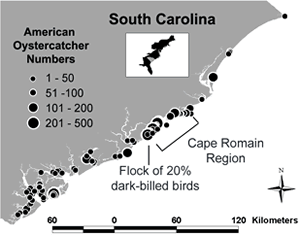American Oystercatchers Wintering in South Carolina

The largest concentration of wintering oystercatchers on the Atlantic coast of the United States occurs in South Carolina. Four statewide surveys of high tide roost sites suitable for oystercatchers were conducted by SCDNR in December of 1999 - 2002. Shorebirds often concentrate in flocks on exposed sites from two hours before high tide to two hours after high tide, thus all surveys were conducted within two hours of high tide.
Three boats were used simultaneously to complete surveys within one week. The surveys examined 998 washed shell mounds, beachfronts, dredge spoil islands, and docks. Three variables were recorded for each flock seen: 1) number of oystercatchers, 2) location of roosting sites and 3) ratio of adult to juvenile birds. Adult and immature oystercatchers can be distinguished by bill color. Adults have bright orange bills and juveniles have brown and dull orange bills.

Surveys revealed the average number of oystercatchers wintering was 3,536. Oystercatchers roosted on washed shell rakes (89%), docks (6%), barrier island beaches (4%) and estuarine islands (1%). The Cape Romain Region of the South Carolina coast from Cape Romain National Wildlife Refuge south to Dewees Inlet had a high number of oystercatchers. The Cape Romain Region had 57% of South Carolina's wintering oystercatchers yet this area comprises only 7% of the coastline. Nine percent of birds examined had immature bill coloration.
South Carolina supports just over one third of the oystercatchers that winter on the Atlantic and Gulf coasts of the United States (estimated total = 10,000). Although the Cape Romain Region has a relatively high number of oystercatchers, there is evidence that these numbers are a small proportion of the total that once existed in this area. The Christmas bird count in December of 1970 reported 8,121 oystercatchers on a route in Cape Romain National Wildlife Refuge. Today, only 200 - 300 birds can be seen along this route.
